Fingal is a slow mover but then he is 85 years old. Fingal is a Belgian barge that somehow ended up rusting in the Corpach boat yard in Fort William in the Scottish Highlands, the south-western end of the Caledonian Canal. There Fingal was spotted by Martin Balcombe, who was told that the beautiful boat would be sold for scrap unless someone came along soon and bought it. Balcombe looked at the barge and had his Eureka moment. He came up with the bright idea of rescuing it by turning it into a kind of floating hotel that would sail up and down the Caledonian Canal and provide people with activity holidays.
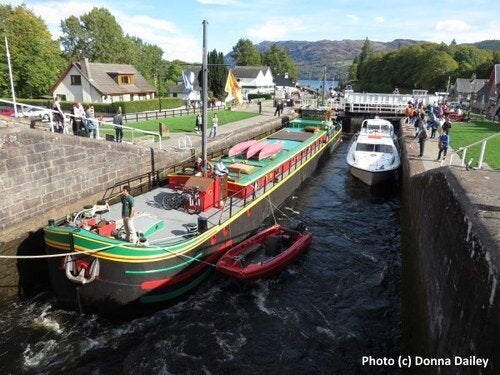
Fingal in the Locks at Fort Augustus
In 1995 Fingal - now bright and shiny and with 12 berths in 6 cabins - took the first passengers between Fort William and the canal's north-eastern end, in Inverness. Today Balcombe's company, Caledonian Discovery, offers a range of activity holidays including cycling, canoeing, sailing, wildlife and music. The most popular of all, though, and the reason I find myself trying to steer Fingal through Loch Ness, is walking. I've joined one of the Country Walking weeks on board Fingal.
The problem with steering a barge that's 39 metres long is that it's very slow to respond. 'I've got a lot of slack in the chain today,' says Fingal's Kiwi skipper, Peter. 'You can turn the wheel quite a long way and it'll have no effect whatsoever. When you feel a bit of tension, then you can start to change the direction. And then you just have to sit back and see what happens!'
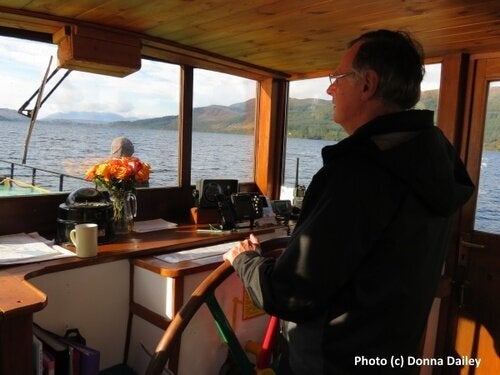
The Author Aims for Fort Augustus
That was the tricky bit. Peter was wanting me to aim for Fort Augustus in the distance, at the far end of Loch Ness. I turned the wheel right... and nothing happened. So I turned it some more, only to find the first turn starting to take effect, so I was soon veering too far to the right. Trying to correct the turn had the same effect. Turn-turn-turn-pause-pause-pause-nothing-nothing-turn-turn-turn... oops!
'You get used to it,' Peter said kindly, but as we got closer to Fort Augustus I decided it was safer to hand the wheel back to the skipper. He now had the task of taking Fingal into the first of the flight of locks at Fort Augustus that mark the next section of the Caledonian Canal as it leaves Loch Ness. It was like threading a needle.
It had been a wonderful morning, though. We had a few hours off from the daily walks that are a feature of the holiday. But in doing so we spotted some wildlife that you can only see when out on the waters of Loch Ness. No, not Nessie, but wild goats. They live on steep cliff faces on the south-eastern side of the loch, where no roads go. Even hikers and campers who venture there are lucky to see a wild goat, as the cliffs are barely accessible from the land and the goats keep out of the way of humans.
Everyone was out on deck with their binoculars when the first goats were spotted. There were three of them, right by the shore. One was a white female with a white kid, and then we made out a dark brown male, sitting down to one side. It was only as the boat moved along and the male became outlined against the whiteness of the female that we saw the huge horns it had, like devil's horns. The skipper said he'd never seen a kid before and never seen goats so close to the water, despite going up and down the loch all summer long. A little later we saw two more white goats, one of them a kid, half-way up sheer cliffs in one of those 'how on earth do they do that?' situations.
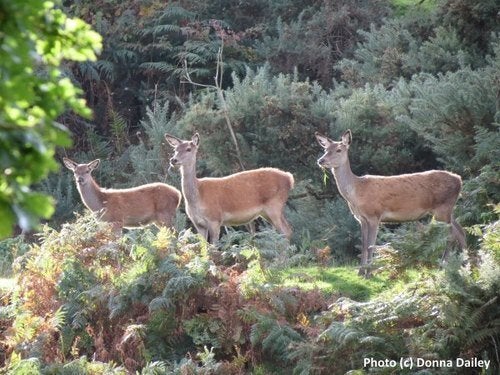
Most days there were wildlife sightings - and sounds too. In the evening we would hear stags calling from the shores, and we watched huge herds of deer grazing on the lush grassy hills. Most days there were walks too, though some people occasionally had lazy days and drifted along with the barge and a book to read.
The walks were mainly fairly easy ones of 5-6 miles, the longest being 11 miles. Our guide, Adam, was a jovial and knowledgeable leader, full of facts after months hiking the paths of the Great Glen. When was the canal built? How long is it? What's that tree?

Taking the Tender to Shore
One day we moored in Loch Dochfour, Loch Ness's little northern neighbour, and took the tender into a pretty and hidden cove that could have stepped straight out of Swallows and Amazons. Here some rather derelict looking boats were tied up and we saw a dipper sitting on one of them before bobbing into the water and flying away. We then walked through woodland where ferns stretched into the forest like a rippling green sea. Heather lined the path but was past its best in these autumnal days.
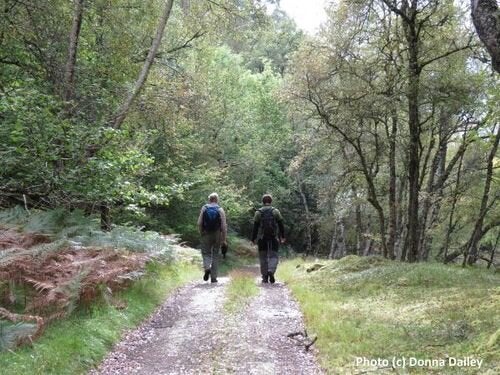
We turned off the path and into the grounds of Aldourie Castle, a cross between a Central European castle and Disneyland.
'If you're interested,' said Adam, 'it costs about £30,000 a night to rent it. Last time I took this walk, Charlie Sheen was staying there. And now, if we carry on this way, I'll show you the best view you'll see all day.'
And he did. We made our way through Torr Wood to Torr Point, almost at the very top of the 23-mile-long Loch Ness. From there, our breath suitably taken away, we gazed in awestruck silence along the entire length of the loch, just about able to pick out Fort Augustus at the far end. Eventually it was time to return to Fingal, our floating hotel, enjoy a beer from the Loch Ness Brewery, go over the day and talk through the plans for the next one. Martin Balcombe's Eureka moment certainly worked.
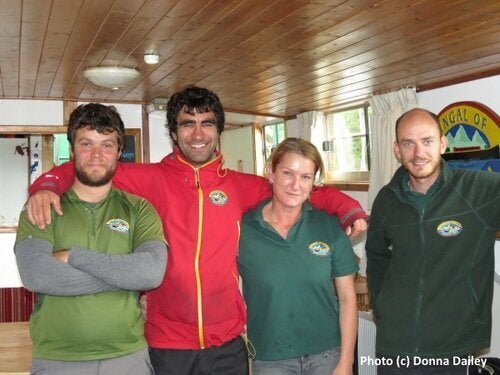
Fingal's Crew of Four
MORE INFORMATION
Visit the Caledonian Discovery website.
THE AUTHOR
Mike Gerrard is an award-winning travel writer who visits Scotland regularly and publishes the Beyond London Travel website.